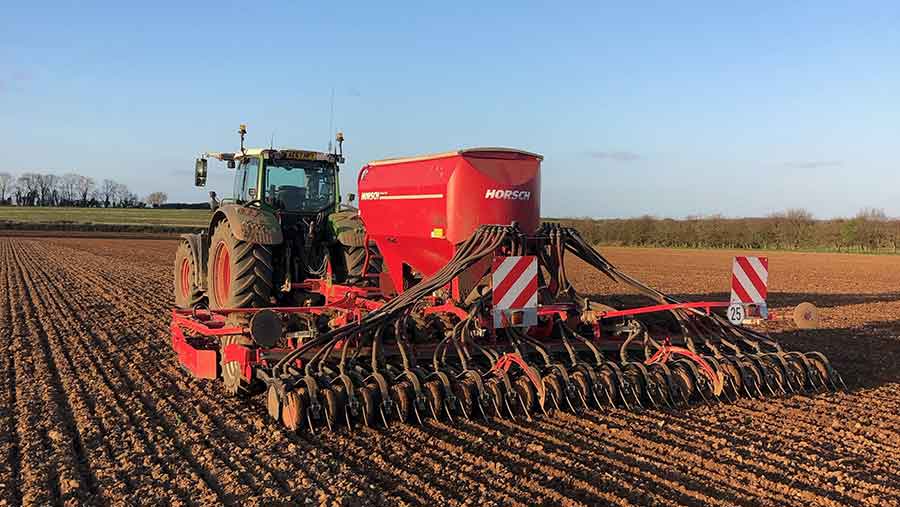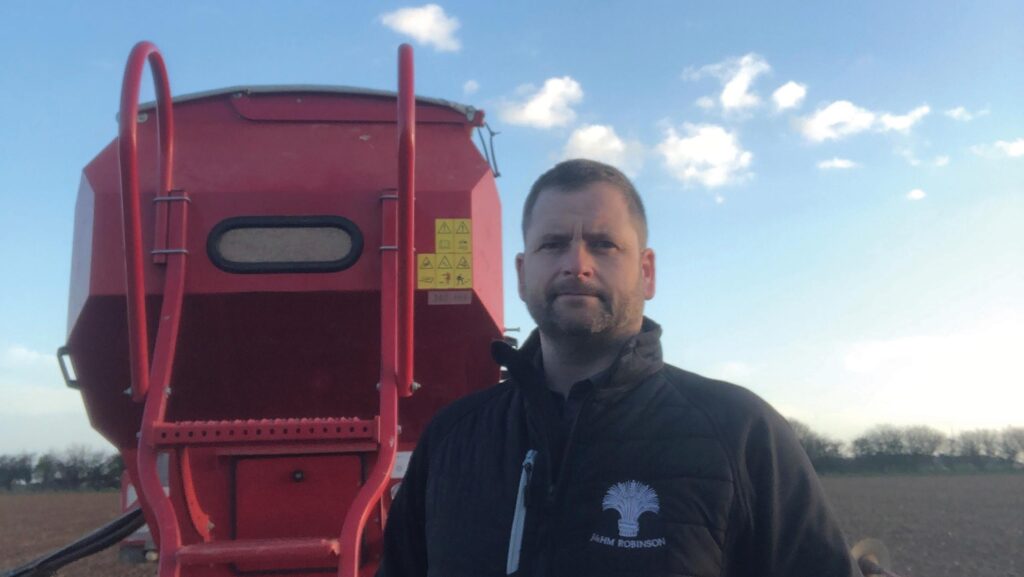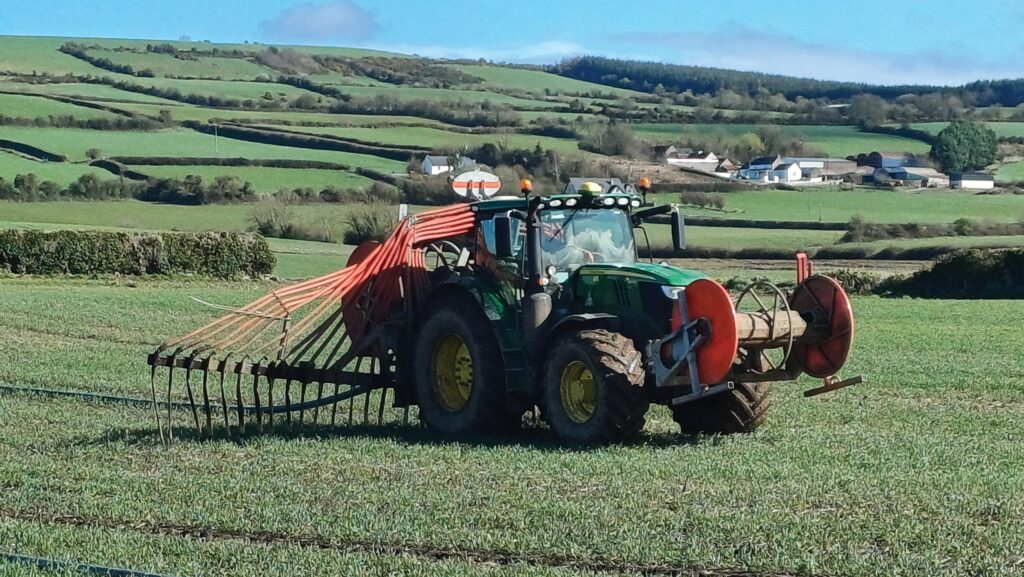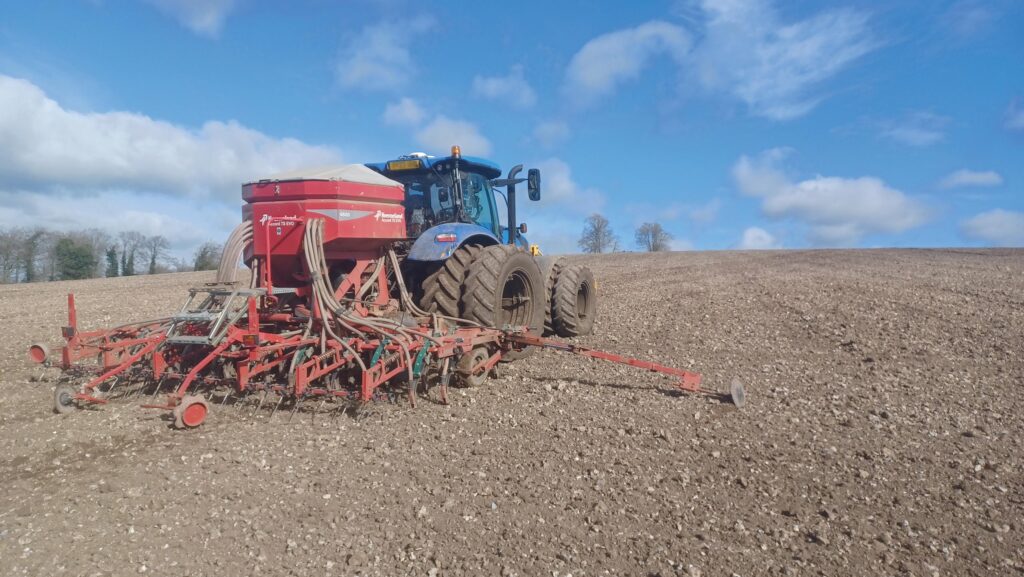Spring drilling: 3 farmers battle to get crops established
 © Jack Robinson
© Jack Robinson Wet weather is causing havoc with spring drilling.
Some farmers have nearly finished while others are yet to begin, as yield potential falls with each delayed day.
Farmers Weekly‘s deputy arable editor Emma Gillbard asked three growers for their insights on the season.
See also: How two farmers are cutting back on fungicides this spring
Norfolk farmer three weeks behind schedule
North Norfolk arable farmer Jack Robinson has been dodging continuous rain showers to get a third of his spring barley drilled, but with oats, peas and sugar beet still waiting to be planted he is three weeks behind schedule.
“It has been a frustrating spring,” says Jack. “We’re picking and choosing which fields are ready. We usually run a min-till system but we’ve reverted to the plough in some fields to help dry soils and get crops established.
“Most fields have a wet spot in, and we’ve had a tractor stuck in a few instances.”
The farm received 141mm of rain in February alone – that’s about 100mm more than average for the month.
Jack managed to establish 25ha of Laureate spring barley in February, which is up and away and received its first dose of nitrogen (N) at Crossways Farm, North Creake.
“Living on the north Norfolk coast, we have quite free-draining sandy soils which allows us to get on the land early, but we can lose yield later in the season when things dry out,” he says.
“We’re a good two to three weeks behind schedule compared with the last five years, but you could say this is the more traditional spring drilling slot of years gone by on the farm.”

Jack Robinson has several more crops to sow © Jack Robinson
A further 50ha of barley was planted from mid-March onwards, with another 140ha to go.
However, with delayed drilling comes potential yield losses.
With 150ha of Isabel oats to sow, alongside vining peas, combining peas and sugar beet, the Robinson family are set for a busy few weeks.
Jack remains hopeful the weather will hold out, letting him get the remaining spring cereals drilled over the next 10 to 15 days, but with continuous showers forecast this remains uncertain.
“Once the cereals are in, we shall make a start to sugar beet drilling.
“We now tend to drill a bit later during early to mid-April with yields of 80t/ha, so hopefully we do not lose too much yield.”
Thankfully, the winter drilling campaign went to plan and winter wheat and rye are looking promising, which is taking the pressure off an increased spring cropping area which many farmers are having to deal with.
No spring crops in the ground for Irish grower
Irish farmer James O’Reilly has no spring crops in the ground, yet has drilled a crop every month since August, playing catch up on his winter cropping plans.
The rain started on 20 June at the farm near Kilkenny in the south-east, and has not stopped since, with 800mm of rain out of an average annual rainfall of 900mm.
“It’s been an absolute disaster and a very long dragged-out process,” he says.
“We’ve kept persisting with winter crops, sowing a crop every month from August through to February, but we haven’t planted anything in March.

Pig slurry being applied to winter oats © James O’Reilly
“Luckily, we are not as badly affected as some farmers on the south-east coast who have no winter cereals established – just oilseed rape.”
With 90% of winter crops now drilled at the 1,000ha farm, once the weather permits James plans to establish 80ha of spring oats on the last block of heavy land where spring barley won’t take.
“If we don’t get spring crops in by the 15 April it is a real sprint to the finish line as crops have little time to recover from any stress,” he says.
“A 3t/acre [7.4t/ha] crop quickly becomes a 2t/acre [4.9t/ha] crop and the figures don’t stack up.”
James notes that the season is not too dissimilar to the wet autumn of 2017 – but once the land eventually dried, drought struck and his 5 May sown spring oats yielded a mere 4.5t/ha.
Winter crops, however, are much hardier, he says. September-sown cereals are looking well but October-drilled crops experienced 5% losses.
As ground conditions were so poor, from 20 October the standard trailed tine drill was replaced with a mounted tine drill which went on to plant a further 320ha of winter wheat and winter oats.
Seed rates were increased to 250kg/ha over the winter months, with a 60% survival rate.
“We normally drill winter crops at 130-145kg/ha, but we upped rates to help crops withstand the cold, rain and slugs,” he says.
James’ cereal fertiliser programme usually begins from 1 April to avoid pushing crops early, which can make them vulnerable to disease attack – particularly in the high septoria region.
However, this year crops were crying out for food, he says, which meant sacrificial travel on land for the greater good of the field.
Despite this, August-drilled oilseed rape is looking promising, with 175kg N/ha successfully applied as well as a top dressing of pig slurry on winter wheat and barley grown on an area of lighter land.
Spring drilling complete at Oxfordshire mixed farm
At David Passmore’s mixed farm in Oxfordshire, spring drilling is now complete, with spring barley and combining peas planted into good conditions.
But his thoughts go out to farmers on heavy land hit by the double whammy of the wet winter and spring.
He says: “We’re fortunate to have had some good drilling windows on our free-draining soils, but it’s a real mixed bag out there.
“Some farmers have not had an opportunity to get on the land since October, with potential yield losses associated with not getting wheat planted and now delayed spring drilling.

David Passmore’s Asteroid spring barley sown on 23 March © David Passmore
“My father used to quote – I think it was Adas Group work from 1960s – that from 15 March average spring barley yields dropped 40kg/acre [99kg/ha] per day.
“With warmer summers, I imagine this may be even higher now.”
Getting crops established early if the weather permits is one of David’s key ambitions to make the most of a long growing season which maximises yield.
He aims to push crops through their growth stages so that if high temperatures hit later in the season crops are further developed to withstand stress.
He tends to winter plough and get a frost tilth to dry land quicker and enable an early start to spring drilling.
One thing he doesn’t do is roll crops after drilling, to reduce risk of seed-bed capping.
“We have left all crops unrolled. Some of the spring barley has received over six inches of rain since planting, which could otherwise cause capping and reduce establishment if the land was rolled.
“What we can do is roll the crops when they’re up if weather allows.”
A total of 20ha of spring barley destined for the seed market was planted in February, with the remaining 20ha sown from mid-March onwards.
His crop of Gotham combinable peas, also grown for seed, went into “perfect conditions, with an excellent frost tilth, and are now up”.
With crops looking well so far this season and average yields of 8-10.5t/ha for spring barley and 4-5.5t/ha for peas, David has his fingers crossed for a promising harvest – but “who knows what lies ahead”, he says.

